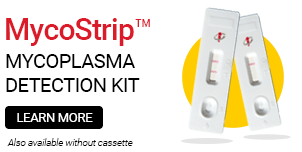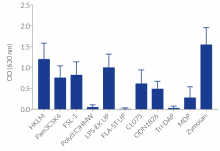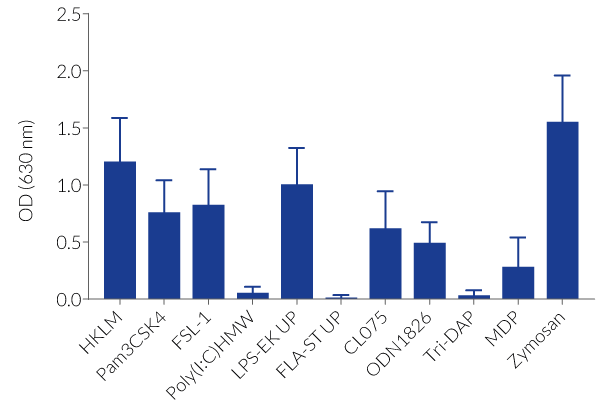RAW-Blue™ Cells
| Product | Unit size | Cat. code | Docs. | Qty. | Price | |
|---|---|---|---|---|---|---|
|
RAW-Blue™ Cells NF-κB-SEAP Reporter Cell Line |
Show product |
3-7 x 10e6 cells |
raw-sp
|
|
||
|
RAW-Blue™ vial Additional cell vial |
Show product |
3-7 x 10e6 cells |
raw-sp-av
|
Notification: Reference #raw-sp-av can only be ordered together with reference #raw-sp.
Mouse macrophage NF-κB-SEAP reporter cell line
RAW-Blue™ cells are designed to monitor the NF-kB and AP-1 responses upon PRR (pattern recognition receptor) stimulation. These cells are derived from the murine RAW 264.7 macrophages. They feature an NF-κB/AP-1-inducible secreted embryonic alkaline phosphatase (SEAP) reporter gene.
RAW 264.7-derived cells endogenously express many pattern-recognition receptors (PRRs), including toll-like receptors (TLRs), NOD-like receptors (NLRs), RIG-I-like receptors (RLRs) and C-type lectin receptors (CLRs) (see figure).
Therefore, RAW-Blue™ cells can be used as:
- TLR reporter cells: they express all TLRs, except TLR5, at different levels
- NOD reporter cells: they express NOD2 and, to a lesser extent, NOD1
- RLR reporter cells: they express RIG-I and MDA-5
- CLR reporter cells: they express Dectin-1
The stimulation with specific agonists of these PRRs induces signaling pathways leading to the activation of NF-κB and AP-1, and the subsequent production of SEAP. Levels of SEAP can be easily monitored using QUANTI-Blue™ solution, a SEAP detection medium (see figure).
Key features:
- Verified expression profile of different PRRs
- Functional validated with a selection of PRR ligands
- Readily monitoring of NF-kB or AP-1 activation by assessing the SEAP activities
Applications:
- Study of various PRRs in innate immunity
- Screening of novel PRR agonists or inhibitors
Specifications
Growth medium: DMEM, 4.5 g/l glucose, 2 mM L-glutamine, 10% (v/v) heat-inactivated fetal bovine serum, 100 U/ml penicillin, 100 μg/ml streptomycin, 100 μg/ml Normocin™
Antibiotic resistance: Zeocin®
Quality control:
- Expression profile of TLRs (TLR1 to TLR9), RLRs (RIG-I and MDA-5), NODs (NOD1/2), and Dectin-1 was determined by RT-PCR and functional assays.
- The stability for 20 passages, following thawing, has been verified.
- These cells are guaranteed mycoplasma-free.
Back to the top
Contents
- 1 vial containing 3-7 x 106 cells, in a cryovial or shipping flask
- 1 ml of Zeocin® (100 mg/ml)
- 1 ml of Normocin™ (50 mg/ml)
- 1 ml of QB reagent and 1 ml of QB buffer (sufficient to prepare 100 ml of QUANTI-Blue™ Solution, a SEAP detection reagent)
![]() Shipped on dry ice (Europe, USA, Canada and some areas in Asia)
Shipped on dry ice (Europe, USA, Canada and some areas in Asia)








